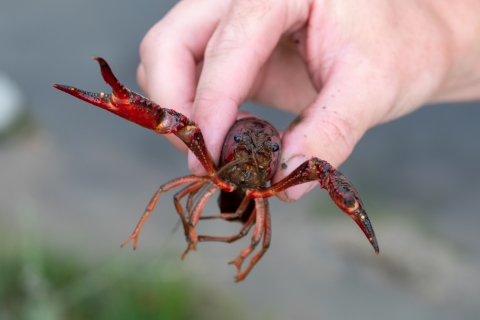Originally from the southeastern U.S., the red swamp crayfish has become an unwelcomed world traveler. They have drained wetlands in Europe and ruined rice crop in Asia. These invasive crayfish are highly aggressive and mobile. Here in the U.S., they are commonly spread by unsuspecting aquarium-hobbyists or biology teachers releasing the unwanted pet into their backyard ponds and rivers. Despite the destructive nature of this species, we at the U.S. Fish and Wildlife Service haven’t given up the fight.
As economies and ecosystems around the world struggle to contain this invasive, researchers funded by the Great Lakes Restoration Initiative in Michigan are leading the charge to develop practical eradication techniques.
In 2017, the red swamp crayfish initially found its first Michigan home in a hotel retention pond. The Michigan Department of Natural Resources spent three years trapping and removing more than 100,000 crayfish from the pond without ever reaching eradication.
Michigan has been trying to control booming populations of invasive red swamp crayfish for six years, and intensive efforts have only made a dent in their numbers. Thankfully, Michigan is no longer in the fight alone.
We are partnering with the Michigan Department of Natural Resources, Michigan State University, Auburn University and the U.S. Geological Survey to develop invasive crayfish control technologies. Serving as a hub for innovative eradication techniques, the initiative-funded partnership creates a direct research-to-management pathway.
If Michigan can learn to control invasive crayfish, innumerable ecosystems could be saved.
“They’re just so prolific,” said Kathleen Quebedeaux, an invasive crayfish biologist for the Michigan Department of Natural Resources. “They make so many eggs and are extremely hardy. It seems like they can live anywhere.”
Quebedeaux works with her team on the ground to manage and monitor the invasive populations. She said that even though these crayfish are native to the southern U.S., they are surviving and even thriving here in the midwest.
Brian Roth, an associate professor at Michigan State University, works in the lab and in the field, searching for solutions to invasive crayfish issues. He said that this initiative-funded project is different from any other he has been a part of. A major barrier to successful invasives management is the extensive time it takes to learn new techniques and apply them. Roth stressed that a good idea in the lab doesn’t always translate to the field.
“It is our rapid integration,” Roth said, explaining what makes this program so unique. “I’m not talking 10 years here, I’m saying in the next year we’ll find a way to scale a lab project up to the field.”
Efforts to control red swamp crayfish have included daily trapping, filling burrows, sound baiting, biological predation control and X-ray sterilization, among other efforts. All of these approaches take a significant amount of time, money and scientific expertise. The team is excited to be developing techniques that bypass trapping and culling all together. They hope to find the most efficient and effective methods of management.
If red swamp crayfish numbers were to spiral out of control, their effects would be devastating to our waters. Red swamp crayfish are more aggressive than native crayfish, outcompeting them for food and space. The invasive is quick to disperse and has more stamina to travel. At infected retention ponds, the invaders have been found inside drainage pipes, meaning they have access to the greater watershed.
Furthermore, unlike native species, the invasive’s burrowing habits are so intense they can collapse underground infrastructure as the sediments supporting piping shift and erode. Their burrows form unwanted drainage from wetlands. If left unchecked, these effects will ruin water quality, erase wetlands, collapse riverbanks and decrease water levels in beds of wild rice also know to the Anishinnaabeg people as manoomin.
“People are paying attention because it’s not just Michigan, it’s the entire Great Lakes basin,” said Roth.
With the constant stream of invasive species invasive species
An invasive species is any plant or animal that has spread or been introduced into a new area where they are, or could, cause harm to the environment, economy, or human, animal, or plant health. Their unwelcome presence can destroy ecosystems and cost millions of dollars.
Learn more about invasive species into our waterways – such as the recent invasion of signal crayfish into Minnesota – the need to control invasive crayfish populations and protect native species is greater than ever.
“This invasive,” said Quebedeaux, “can be really harmful to all of our amazing resources in Michigan, things like water clarity which impact our native species abundance. If you like to get outdoors and see clean water, then you should care about this.”





